Brendan Coates, Dougal Horton, and Lachlan McNamee1
China's rise as a merchandise exporter in recent decades is unparalleled. Supported by a rapidly growing urban workforce, massive investments in productivity-enhancing infrastructure and technologies, a range of subsidies and incentives, and a favourable external economic environment, Chinese merchandise exports reached a staggering 36 per cent of China's GDP in 2006. However, this remarkable export performance, which is somewhat exaggerated by China's assembly role in global supply chains, is unlikely to continue, as Chinese exports reach saturation point in some export markets and domestic wages continue to rise. Instead, future export growth will increasingly be led by shifts in China's exports towards more sophisticated goods and services as China adopts more advanced manufacturing technologies, and towards emerging economy destinations. This will underpin continued rises in China's productivity and living standards, allowing consumer spending to become a more important internal driver of growth, as the economy reduces its reliance on export and investment demand.
Introduction
Following in the footsteps of other Asian economies such as Japan, South Korea, Hong Kong, and Taiwan, China's rapid industrialisation and economic growth has been underpinned by its export sector. This has seen a rapid expansion in China's international trade, with merchandise exports directly accounting for approximately one-fifth of Chinese economic growth over the past decade. Over this period, investments to expand industrial capacity in China's export-oriented industries have also been an important contributor to the investment boom.
The importance of China's export sector, however, extends well beyond its direct contribution to China's GDP, which is sometimes overstated (see Box 1). Rather, China's 'export-led growth' model has played a much broader role in transmitting new technologies and business practices to the wider economy, leading to substantial productivity gains. This has helped to drive China's economic growth to an annual average rate of 10 per cent since the reform period began 30 years ago.2
Notwithstanding concerns regarding China's trade practices amongst its trading partners, the rest of the world has largely benefited from this growth strategy, especially through lower prices for many internationally tradable goods, for both consumers and businesses.
In recent years, however, a number of commentators have suggested that China can no longer depend on exports as a driver of economic growth (for example, World Bank, 2012; Deer and Song, 2012; Akyuz, 2011; Guo and N'Diaye, 2009). China's comparative advantage in low-skilled manufacturing is threatened by the upward adjustment in its exchange rate and rising costs, particularly for labour. With China already accounting for over one tenth of global merchandise exports, future export growth is likely to slow as China approaches saturation point, at least in its existing export mix. Furthermore, the significant imbalances that emerged over the past decade — including China's large external trade and current account surpluses — highlights the unsustainability of a growth model that has been heavily reliant on investment and export demand.3
Future Chinese economic growth derived from exports is likely to be largely driven by manufacturers moving up the value chain to secure a greater role in the production, design, and marketing of industrial products and services. Moreover, new engines of growth in higher value-added industries will be increasingly more technology- and knowledge-intensive, placing a high premium on effective innovation and investment in education and research and development (Spence, 2011).
The relative decline in exports as a driver of GDP growth, and the shifting structure of Chinese exports, are inevitable steps in China's economic development, similar to the experiences of former export-oriented emerging economies. The challenge will be to support these structural transitions while avoiding sudden slowdowns and possible crises (World Bank, 2012). If China can get the policy mix right, this will support growing household incomes, which should see consumer spending become an increasingly important internal driver of China's growth as living standards rise.
This paper examines these issues. The first section investigates the emergence of China as a leading exporter of manufactured goods, and broader trends in Chinese exports over the past decade. The second section assesses the impact that rising wages and other input costs, and renminbi (RMB) appreciation, are having on China's export competitiveness. The third section examines the shifts in China's industrial structure and export mix, and examines prospects for future export-led growth. The fourth section considers the implications of these transitions for China and the region, as well as the global economy, and the final section concludes.
Box 1: Estimating the direct contribution of exports to growth
Although nominal merchandise exports have fallen from a peak of 36 per cent of GDP in 2006 to 26 per cent in 2011, it is clear that China exhibits a degree of external dependence well in advance of the world's other largest economies.4 This ratio, however, does not mean that exports account for 26 per cent of Chinese GDP, as a significant proportion of the value of Chinese merchandise exports comes from imported materials and components.
For example, Xing and Detert (2010) estimate that only US$6.50 (about 3.6 per cent) of the total manufacturing cost of an Apple iPhone in 2009 could be attributed to production activities inside China, yet the full shipping price (US$178.96) is reported in China's gross exports. Instead, the bulk of its exported value is accounted for by the cost of components imported from elsewhere, such as Japan (34 per cent), Germany (16 per cent), and South Korea (13 per cent).
Hence, we adopt the estimates of the domestic value-added (DVA) share of Chinese merchandise exports generated by Koopman et al (2012) to provide a better estimate of the importance of exports to the Chinese economy.5 Measuring the DVA content of exports helps to capture China's role in global supply chains. Based on this approach
we estimate that from World Trade Organization (WTO) accession at the end of 2001 through to 2008, DVA in merchandise exports contributed approximately 25 per cent of China's total GDP growth — significantly higher than in the four years prior to accession. This fell to 23 per cent over the two year period from 2010 (Panel A).6 Further, merchandise export activities directly accounted for 17 per cent of GDP in 2011, down slightly from just prior to the Global Financial Crisis (Panel B). These results demonstrate that China remains linked to global economic developments via demand for its exports, although less so than the gross export figures may suggest.
Chart 1: Chinese merchandise exports in value-added terms
Panel A: Contributions to GDP growth
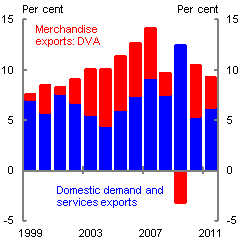
Panel B: Ratio of exports to annual GDP
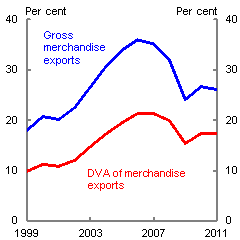
Source: Koopman et al (2012); CEIC China Database; Treasury estimates.
Notes: Services exports account for approximately 10 per cent of total gross Chinese exports.
The emergence of China as the world's factory
Chinese international trade has expanded rapidly in recent decades, with China's 2001 accession to the WTO leading to an even greater acceleration. The average annual rate of growth in nominal merchandise exports surged to 27 per cent from 2002 to 2008, almost double the average rate of growth in the 1990s. China became the world's largest exporter in 2009, surpassing both the United States and Germany, and now accounts for over one tenth of world merchandise exports by value (Chart 2, Panel A). With China's nominal export growth outpacing its rapid economic growth, gross merchandise exports rose quickly to peak at the equivalent of 36 per cent of GDP in 2006 (Chart 2, Panel B).
Chart 2: China's remarkable export growth
Panel A: Share of global exports and GDP
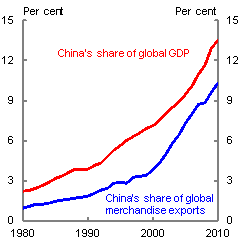
Panel B: As a per cent of Chinese GDP
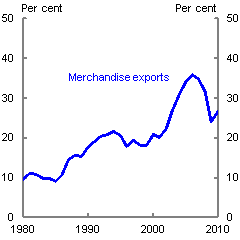
Source: World Bank World Development Indicators 2011; IMF World Economic Update, October 2012.
Notes: GDP is in PPP dollars (Panel A), US dollars (Panel B).
Rapid export growth has been largely driven by China's participation in vertically integrated global production supply chains — where different activities in the production of a single good are carried out in different economies.7 Chinese factories often form the final link — assembling and packaging the textile, light manufacturing, and electronic components that are primarily designed, produced, and marketed abroad. This is reflected in the high share of processing exports in total Chinese trade and is consistent with the outsourcing strategies of foreign firms that have shifted low-skilled, labour-intensive production processes to China (although as illustrated in Chart 3, Panel A, the value of ordinary exports has recently eclipsed that of processing exports).8
The abundant supply of comparatively low-cost labour and other factor inputs, the potential to utilise significant economies of scale, and the prospect of gaining access to China's growing domestic market have made China an attractive target for foreign investment and outsourcing.9 Foreign funded firms account for just over half of Chinese merchandise exports, although this share has declined as local firms expand their productive capabilities and target foreign markets (Chart 3, Panel B).
Chart 3: China's processing exports
Panel A: Share of merchandise exports by trade regime, 12mma
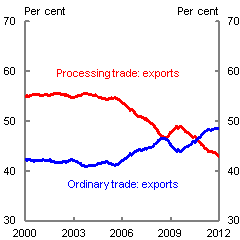
Panel B: Share of merchandise exports by foreign funded enterprises, 12mma
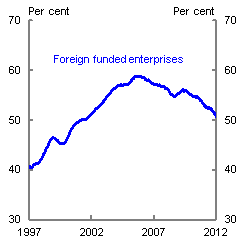
Source: CEIC China Database; Treasury.
Notes: 2012 data is year to October.
Trade, and the associated inflows of foreign direct investment, have helped China gain access to global markets and new technologies, which have been essential in China's economic development. Foreign firms typically produce more sophisticated goods than domestic firms and are more productive (Xu and Lu, 2009).
Since China joined the WTO in 2001, Chinese producers have almost doubled their share of the combined United States, European Union and Japanese market for imported goods, to 18 per cent in 2011 (Chart 4, Panel A). Together, these markets accounted for around half of all Chinese merchandise exports during this period. Over the same period, Japan's share of US imported goods fell from 11 to 6 per cent, and halved to 4 per cent of goods imported by the EU.
China has also gradually shifted up the production value chain towards more sophisticated products, such as heavy manufactured goods and electronics. China's share of US, EU and Japanese imports of such goods more than tripled between 2001 and 2011, to 28 per cent (Chart 4, Panel B). Although gross export values inflate these market shares due to China's role as a final stage assembler in global supply chains, these results coincide with the growing value-added share of Chinese producers in total exports of merchandise goods, discussed in greater detail below.
Chart 4: China's share of advanced economy merchandise imports
Panel A: Total imports
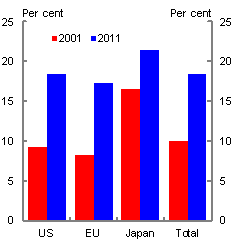
Panel B: Heavy manufacturing and electronics
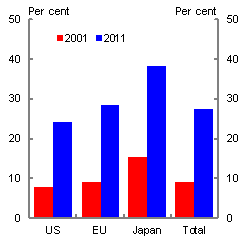
Source: UN Comtrade; Treasury.
Notes: The above product groupings are based on the authors' calculations using trade data classified under the Harmonized Commodity Description and Coding System (HS). See Appendix A for further details.
China's unparalleled rise as a merchandise exporter in recent decades also reflects a long period of relatively favourable conditions in the global economy prior to the global financial crisis (GFC). This supported growing demand for China's merchandise exports, particularly from advanced economies. Reflecting this external dependence, China's exports fell 16 per cent in 2009 as advanced economy demand contracted in the wake of the GFC, belying arguments that China had 'de-coupled' from the global economic cycle (for example, see Anderson, 2007).
Export growth rebounded during 2010 and 2011 following an initial recovery in global conditions, but has decelerated substantially in 2012. Merchandise exports are 8 per cent higher in the year to date to October, compared to the Government's 2012 export growth target of 10 per cent, as advanced economy demand has remained relatively weak.
While advanced economy demand was a key ingredient in China's impressive export performance in the previous decade, this is unlikely to remain the case, at least in the medium term. This reflects an unfavourable outlook for advanced economies, with ongoing austerity measures and continued uncertainties around the European sovereign debt crisis likely to remain a drag on growth. This means that export demand from emerging economies will play an increasingly important part in driving China's export performance, an issue which is discussed further below.
Shifts in China's export competitiveness
Abundant supplie
s of low-cost labour and artificially cheap inputs to production, as well as an undervalued currency, have formed much of the basis for China's comparative advantage in low-skilled and labour-intensive manufactured exports in recent decades. Yet as the Chinese economy develops, labour and other input costs are rising, particularly in the more advanced export-focused coastal regions. These pressures on costs and competitiveness have been compounded by the gradual appreciation in the RMB. China's real effective exchange rate has appreciated by almost 30 per cent since major exchange rate reforms in mid-2005. As these trends continue — and as other low-cost emerging markets continue to make productivity-enhancing investments in their own export sectors — China is likely to become less competitive in low-cost manufactured exports, bringing into question the prospects for future export-led growth.
Rising wages and other factor input costs
The large-scale migration of rural surplus labour to the urban manufacturing sector has provided manufacturers in China access to a deep pool of low-cost labour. This has driven China's rise as the final-stage assembler in global manufacturing supply chains and the subsequent rapid growth of labour-intensive manufactured exports. However, as the availability of rural surplus labour shrinks and the Chinese Government continues to grant minimum wage increases, China's low-cost wage advantage is gradually dissipating.10 Nominal wages have grown by an annual average rate of almost 15 per cent since China's accession to the WTO in 2001.
At the same time, efficiency gains resulting from past rounds of market reforms and the migration of excess labour from the lower-productivity agriculture sector to the higher-productivity manufacturing sector are slowing.11
Recent studies suggest that Chinese unit labour costs (ULC), which adjust labour costs for productivity, have risen since the early to mid-2000s as productivity gains have been insufficient to offset wage rises. Ceglowski and Golub (2011), for example, found that between 1998 and 2003 productivity gains substantially outpaced wage growth, leading to a fall in ULC of between 1.5 and 5.2 per cent on average per year in RMB terms. Between 2003 and 2008-09, however, these trends reversed and ULC rose by between 1.8 and 7.4 per cent on average each year. ULC rose even faster in US dollar terms, by an annual average of 5 to 10.9 per cent, reflecting the appreciation of the RMB.
Historically, domestic prices of key inputs such as land, water, energy, and fuel have also been relatively low by international standards, partly reflecting government policies that have regulated below-market prices (World Bank, 2012).12 In recent years, however, China has begun to address factor market distortions, with a greater policy emphasis on market-based pricing and the scaling back of subsidies. For example, petroleum and diesel prices are now indexed to a weighted basket of international crude oil prices; natural gas prices are steadily increasing; and preferential power tariffs for energy-intensive industries are gradually being removed.
Domestic financial and capital market reforms, which are a crucial component of China's broader structural reform agenda, may also increase the cost of capital, including for exporting firms.13 Over time, reforms will move towards the development of a market-based credit system and the subsequent removal of the implicit subsidy on the cost of capital for Chinese enterprises. While higher capital costs may not directly impact foreign-funded manufacturing firms, these firms may be indirectly impacted by the flow-on effects from local suppliers.
Exchange rate appreciation
Shifts in the nominal exchange rate could also affect Chinese export competitiveness. As the RMB appreciates, the prices of Chinese products rise in foreign currency terms. Since the de-facto currency peg against the US dollar was removed in favour of a link to a basket of currencies in July 2005, the RMB has appreciated by approximately 20 per cent on a nominal trade-weighted basis and by over 30 per cent against the US dollar.
The combined effects of exchange rate appreciation and increases in wages and other production costs can be seen in movements in the real effective exchange rate (REER).14 Since mid-2005, China's REER (as measured by the Bank for International Settlements) has risen almost 30 per cent. This appreciation is substantially greater than in many of China's principal trade competitors in Asia. Over the same period, the REERs for Indonesia and Thailand have both risen by less than 20 per cent, and by only 1 per cent for Japan. India's REER has fallen 3 per cent, and the REERs for Korea and Taiwan have both fallen by more than 15 per cent.
Impacts on China's international competitiveness
Despite clear signs of rising labour and other input costs, the pass-through of currency appreciation and cost increases into the prices of China's exports has been minimal to date. For example, according to the China import price index from the US Bureau of Labor Statistics (which adjusts for changes in the quality of imported goods) the growth in US prices of goods imported from China has been relatively subdued, with prices rising by just 6 per cent since July 2005 (Chart 5, Panel A).15 Moreover, as shown in Chart 5, Panel B, increases in the US prices of Chinese goods compare favourably with its Asian trading competitors.
Chart 5: China's external competitiveness
Panel A: Exchange rate
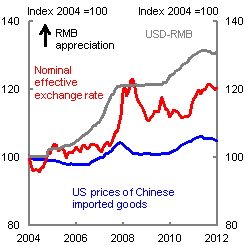
Panel B: US prices of Asian imported goods
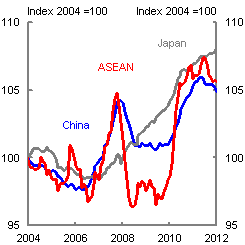
Source: CEIC China Database; Reuters Ecowin; Treasury.
Notes: 2012 data is year to October.
This surprisingly modest rise in the prices of Chinese goods partly reflects that approximately a third of the value of Chinese merchandise exports is produced offshore, with Chinese exporters benefiting from cheaper input costs for imported components (see Table 1) (Humpage and Jacobson, 2012). It also likely reflects the low wage share of the value of Chinese exports, especially for more sophisticated export goods, and demonstrates the importance of ongoing productivity gains to partially offset rising wages.
While apparently modest, the price inflation of Chinese merchandise goods in recent years has coincided with a tapering-off in China's share of a number of major merchandise export markets, including the US, EU and Japan.
This mainly reflects a marginal fall in China's share of the textile and light manufacturing markets (in the US, EU, and Japan), from almost 56 per cent in 2010 to 54 per cent in 2011 (after jumping from 34 per cent in 2001). Textiles and light manufactured goods are more labour-intensive in production than goods higher up the value chain and efficiency gains may be harder to come by. Thus, these products are more sensitive to rising labour costs. While China still commands a dominant market share in this category, there is evidence that other emerging economies are beginning to gain a foothold. For example, between 2001 and 2011 Vietnam's share of these goods mar
kets rose from 1.4 to 4.3 per cent.
While Chinese merchandise exporters may have experienced a modest loss of competitiveness in recent years, their share of world merchandise exports could not have increased indefinitely. China is, or could soon be, at the 'Lewis Turning Point' (or more likely, a 'turning period') whereby the gains from the migration of rural surplus labour to the manufacturing sector will diminish as the supply of rural labour tightens, placing upward pressure on industrial wages.16
Indeed, becoming less competitive in lower-end merchandise trade is an inevitable result of China's ongoing economic development, as its economy shifts towards higher value industries requiring more expensive technologies and labour. As this process unfolds, and as alternative suppliers in lower-wage economies, such as Bangladesh and Vietnam, come on line, China is likely to continue to lose international competitiveness in lower-end, labour-intensive products.
A loss in competitiveness in some sectors, however, may free up resources for a shift to higher domestic value-added in others, and need not imply a decline in competitiveness for the economy overall. Over the longer term, rising wages and other costs causing less competitive industries to be replaced by more productive industries is inherently positive for prospects for sustainable Chinese economic growth.
Prospects for China's exports sector
In the short-term, the decline in Chinese competitiveness in these low-end industries is likely to be gradual. China will continue to enjoy unparalleled economies of scale in production, its logistics performance remains superior to all comparable emerging economies (as measured by the World Bank's Logistics Performance Index, 201217) and cost savings may still be available in China's less developed western regions.
Over time, the impact of higher labour costs on existing export industries will be balanced by falling production costs in new, more advanced industries, as these emerging sectors benefit from the latest round of new technologies and capital investment. For many of these products, efficiency gains could help to partially offset ongoing strong wage growth.
This shift will also support a growing share of production taking place onshore, as manufacturers substitute domestically-produced components for imported parts, allowing Chinese exporters to capture a greater share of the export revenue.
Towards electronics and heavy machinery
The shift higher up the production value chain and towards greater value-adding activities is well underway, although this will be a relatively gradual process compared with the rapid industrial development in recent decades.
Chart 6: China's share of global exports by product
2 digit HS export product categories ranked by China's world market share in 2001
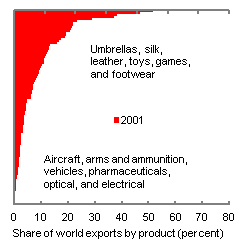
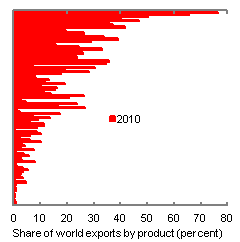
Source: UN Comtrade, Treasury.
Notes: The above product groupings are based on the authors' calculations using trade data classified under the Harmonized Commodity Description and Coding System (HS). See Appendix A for further details.
Chart 6 shows China's world export market shares across product categories from the Harmonized Commodity Description and Coding System (HS) of tariff nomenclature, ranked by China's share of global exports in each of these product markets as they stood in 2001. China's share of some low-end products (generally towards the top of the vertical axis), such as footwear, leather goods and other textiles, and toys, are arguably approaching a saturation point beyond which further advances in market share may not be feasible.
In contrast, China's market share of more sophisticated goods (generally towards the bottom of the vertical axis), such as aircraft, vehicles, arms, and pharmaceuticals, remain much lower than its aggregate world market share, potentially providing greater opportunities for further growth in exports and market share.
In fact, China's shift towards the production of more sophisticated goods can already be seen in the aggregate exports data. Following a ten-fold increase in the combined value of heavy manufacturing and electronics exports, these categories together accounted for 60 per cent of China's merchandise exports in 2011, up from 45 per cent in 2001 (Chart 7, Panel A). China accounted for three of the top ten global construction equipment manufacturers by revenue in 2011, up from zero in 2009, with Sany, Zoomlion and XCMG ranked seventh, ninth and tenth (KHL Group, 2012).
Chart 7: China's shifting export mix
Panel A: Share of Chinese exports by product, 12mma
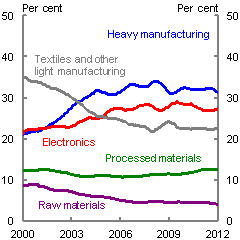
Panel B: Contributions to Chinese export growth by product type
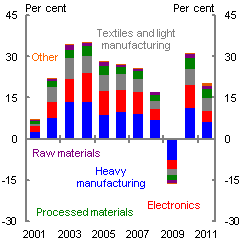
Source: CEIC China Database; Treasury.
Notes: The above product groupings are based on the authors' calculations using trade data classified under the Harmonized Commodity Description and Coding System (HS). 2012 data is year to October.
Towards greater domestic value-adding
Improvements in technology and workforce skills are gradually leading to a greater share of Chinese merchandise exports being produced in China as domestic suppliers increase their production capabilities and quality over time. For example, improvements in the quality and precision of Chinese metal fabrication facilities and processes have allowed China to produce capital goods of increasing quality, with Chinese exporters sourcing an increasing share of components via domestic supply chains (Economist Intelligence Unit, 2011).
The domestic value-added share of Chinese exports increased from 54 per cent in 1997 to 61 per cent in 2007, reflecting upgrades to China's industrial structure (Koopman et al, 2012) (Table 1). Moreover, the ratio of processing exports to imports in processing trade — a measure of the contribution of domestic value-adding activities to processing exports — has since risen from 1.7 to 1.8, suggesting that the share of the final value of China's processing exports generated domestically has increased further since 2007.
| Domestic value-added share of merchandise exports | |||
|---|---|---|---|
| 1997 | 2002 | 2007 | |
| Ordinary exports | 94.8 | 89.6 | 84.0 |
| Processed exports | 21.0 | 25.4 | 37.3 |
| All merchandise exports | 54.0 | 53.9 | 60.6 |
Source: Koopman et al (2012).
The shift towards ordinary, or non-processing, trade (see Chart 3, Panel A) also supports the contribution of exports to GDP growth. Ordinary Chinese trade is dominated by domestic firms that control a greater part
of the production supply chain and produce a greater share of the components used in the production of the final exported product. This means that, dollar for dollar, ordinary exports generate far more domestic activity than the equivalent gross value of processing exports.
Table 1 also shows, however, that the domestic value-added share of ordinary exports has been falling, reflecting a greater use of more sophisticated imported components in ordinary exports. Thus, China's more advanced export mix in recent years may overstate China's current capacity to produce highly sophisticated goods (Xu and Lu, 2009).
Towards services
Although examined only briefly here, increased trade in services — which already accounts for 10 per cent of total Chinese exports — will provide further opportunities for exports to support Chinese growth. Services are the fastest-growing component of global trade, accounting for 20 per cent of the world's total exports in 2010 (Department of Foreign Affairs and Trade, 2012). As economies progress from middle- to higher-income status, the share of GDP accounted for by services tends to increase, reflecting the high income elasticity of demand for services. The share of services in China's GDP has already risen from 20 per cent to over 40 per cent since the early 1980s, and is expected to rise to over 60 per cent by 2030 (World Bank, 2012).
Such a shift may also give rise to a greater role for services in China's exports. Development of the services sector will provide further opportunities for greater on-shoring of manufacturing production processes, since more sophisticated manufactured exports require sophisticated services inputs. This transition will depend, in part, upon further efforts to promote greater competition in services markets. Opening China's services sector to foreign participants, while promoting a strong regulatory framework to ensure competition, could also improve the efficiency of this sector and hence improve efficiency in goods production (World Bank, 2012).
Towards emerging economies
Signs of market saturation in advanced economies amongst some product groups, combined with those economies' subdued growth outlook, means China will need to increasingly rely on the expansion of exports to emerging economy markets to sustain overall export growth.
Chart 8: The shift in China's merchandise exports to emerging economies
Panel A: Exports by destination, 12mma
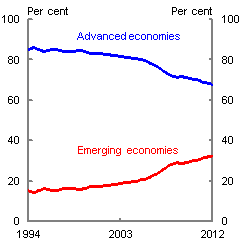
Panel B: Export growth
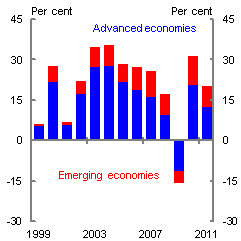
Source: CEIC China Database; Treasury.
Notes: 2012 data is year to October.
This shift is already occurring. Emerging economies are accounting for a progressively larger share of China's merchandise exports (Chart 8, Panel A), and are becoming an increasingly important driver of export growth (Chart 8, Panel B). Emerging economies accounted for almost half of China's export growth in the first half of 2012.
This shift reflects the growing demand from emerging economies for intermediate and capital goods, such as construction machinery and equipment, which they require for their own industrial-led development. Heavy manufacturing exports to emerging economies have grown from 4 per cent of total Chinese merchandise exports in 2000 to 11 per cent in 2011, while exports of electronics have risen from 3 to 7 per cent over the same period (Chart 9, Panel A).
While the share of Chinese exports accounted for by heavy manufacturing and electronics shipped to advanced economies has grown rapidly in recent decades, those shares began to decline from the mid-2000s as emerging economy markets have become more important (Chart 9, Panel B). Thus, as China's export structure increasingly gears towards the production of these more complex goods, and away from light manufacturing, emerging economies will likely become progressively more important as a source of demand for China's exports.
Chart 9: China's shifting export mix, shares of total merchandise exports
Panel A: Emerging economies
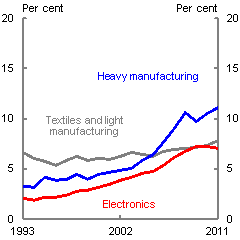
Panel B: Advanced economies
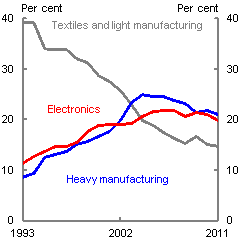
Source: UN Comtrade; Treasury.
Shifting away from export-driven growth?
The Chinese economy will continue to grow strongly in coming decades — albeit at a slower pace than the double-digit rates seen in previous years — as real GDP per capita converges towards that of more advanced Asian economies, such as Korea and Japan (Au-Yeung et al, 2013).
While China's export sector is likely to continue to be instrumental in this economic convergence, the days of substantial trade surpluses and stellar growth in exports have probably passed. Domestic sources of demand, particularly private consumption, are likely to become increasingly large drivers of China's GDP growth.
This 'rebalancing' will largely be an organic process, going hand-in-hand with rises in productivity, wages and household incomes, as Chinese industry moves into increasingly sophisticated goods and services, as outlined above, and produces more for the growing domestic market (Hubbard et al, 2012).
Policy settings, however, will also play a crucial role. China's rapid industrialisation, and government policies designed to foster this process, have led to internal imbalances and deepening domestic structural risks. Combined with the restricted investment opportunities available in China, there are signs that China's excess stock of domestic savings has been increasingly directed into low yielding and unproductive investments.18
In addressing these imbalances, Chinese authorities will need to continue to remove factor price distortions, undertake financial and credit market reforms, and support a more liberalised exchange rate regime (Kong et al, 2012). Over time, this will support increases in the wages and consumption shares of GDP, and a reduced reliance on external demand, moving the economy onto a more balanced and sustainable growth path.
However, should authorities resist this process through the artificial suppression of costs — for example, by maintaining direct subsidies on factor inputs and the low cost of capital, or suppressing nominal exchange rate appreciation — and other anti-market measures to support the industrial sector, this process may be derailed.
Instead, by allowing this adjustment to take place, through continuing to remove subsidies and promoting the sort of innovation and workforce skills that China needs to move up the value chain, household incomes should continue to grow as a share of the economy. This should see consumer spending become an increasingly important internal driver of China's growth, and the economy becoming less reliant on external demand.
Implications for China, the region, and the global economy
China's rise as a merchandise exporter has been unparalleled. While other Asian economies have seen periods of similarly rapid expansion, China's development, with its vast population and labour force, has been on a much larger scale.
China's rapid emergence in recen
t decades has profoundly altered the global economic landscape, as large expansions in China's export supply have placed sustained downward pressure on the prices of global manufactured goods. Internationally, this has significantly boosted the purchasing power of consumers, and, through price falls for intermediate and capital goods, has reduced input costs for many businesses.19
Likewise, the next stages in China's economic development, as it shifts up the value chain, will have profound impacts not only on China, but on the Asian region and the world economy more broadly.
Over time, the forces that placed downward pressure on prices of lower-end global manufactured goods, including China's rapid urbanisation and the initial catch-up in technology, will dissipate, as wages and other input costs continue to rise.
However, China's transition towards — and growing specialisation in — heavy manufacturing and electronics will see the supply of these goods expand, as China increasingly competes with the exports of more advanced economies, such as Korea and Japan. As China's extensive manufacturing capabilities turn to the production of these more sophisticated manufactured goods, downward pressure could increasingly be placed on the global prices of these goods.
This shift, however, will remain gradual. While China has begun to move up the export value chain, the degree of export competition between advanced economies and China — as measured by the similarity of their respective export baskets — remains limited (Economist Intelligence Unit, 2011).
Moreover, China's continued rise will present opportunities for the export sectors of advanced economies. Already, China's emergence as the world's pre-eminent exporter of lower-end and processed manufactured goods has supported greater regional integration and specialisation in global supply chains. As links within these supply chains, advanced economies are engaged in higher-value-adding processing, such as the design and marketing of these goods.
In the same way, China's move towards more sophisticated manufactured exports is likely to give rise to a new set of opportunities for firms in advanced economies. Countries such as Australia will be able to link into these emerging global supply chains, including through the provision of related technical and professional services. Indeed, China has already overtaken the US and Japan to become Australia's largest services export market, accounting for 11.3 per cent of total services exports in 2011 (although this is mostly accounted for by education and tourism).20
While it is difficult to make accurate predictions about sectors that may be affected by shifting patterns in Chinese growth and development, Australia is in a good position to capture some of these new opportunities. Australian firms must continue to forge stronger links with Asian supply chains and focus on innovation and their 'Asia knowledge' to develop products and services that are valued in the region. In a broader sense, Australia must maintain an outward orientation to foreign investment, focus on workforce skills, and harness the power of markets to allocate resources more efficiently and to drive innovation and investment (Australian Government, 2012).
China's rising cost base will also present new opportunities for economies with relatively low wages and favourable logistics and infrastructure. For example, according to the outcomes of the World Bank's Logistics Performance Index (2012), possible beneficiaries of China's rising manufacturing cost base include Malaysia, Thailand, India, Philippines, South Africa, Brazil, and Vietnam, which all recorded favourable indices for their relatively low levels of per capita GDP (Chart 10).
Chart 10: Logistics performance and per capita incomes
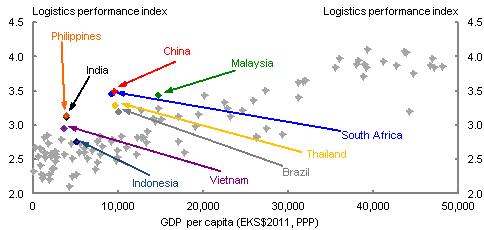
Source: World Bank, Connecting to Compete: Trade Logistics in the Global Economy, 2012; The Conference Board Total Economy Database, January 2012.
Notes: GDP per capita is in US$2011 weighted using output at Èltetö-Köves-Szulc (EKS) purchasing-power-parity (PPP) exchange rates.
The composition of China's exports, and their contribution to economic growth, will also remain important for global commodities demand, particularly coal and iron ore, and energy resources. Embodied metals exports will become an increasingly important driver of domestic steel demand as China moves up the value chain towards more sophisticated, metals-intensive manufactured goods, such as advanced machinery and automobiles (Rio Tinto, 2012).21
Moreover, investments to upgrade and expand the industrial capabilities of China's manufacturing industries are likely to be another key driver of future Chinese steel demand, alongside infrastructure and property construction as China's urban population continues to grow.
Conclusion
China's export sector has proved pivotal to Chinese economic growth and industrialisation over recent decades. Its development has led to the dissemination of new technologies and business practices to the wider economy, driving productivity gains and wage growth, and has supported the ongoing transition of China's productive capabilities higher up the value chain.
In the coming decade, the direct contribution of the export sector to economic growth will inevitably decline. Rising labour and other input costs, currency appreciation, and modest growth prospects in advanced economy markets will all present challenges to future export growth, especially for low-skilled manufactured goods. And with China already accounting for over one tenth of global merchandise exports, future export growth will be harder to come by as China approaches saturation point in some of its existing export markets.
Exports will continue, however, to play an important role in China's economic development. Despite rising rapidly, Chinese per capita incomes remain well below those of advanced economies and its export mix remains relatively unsophisticated. Over time, China's export industries will continue to shift towards higher value-adding activities and more sophisticated goods and services as productivity rises, and towards emerging economy markets. These transitions will continue to support increases in household incomes and consumption, even as aggregate growth slows from the double-digit rates seen in previous years.
The relative decline in exports as a driver of GDP growth, and the shifting structure of China's exports, are inevitable steps on China's path of further economic development, following in the footsteps of former export-oriented emerging economies such as Hong Kong, Korea and Japan. The challenge for the Chinese authorities will be to support these structural transitions with appropriate policy settings, while avoiding sudden slowdowns.
This will require continued innovation and improvements in workforce skills, the ongoing removal of factor price distortions, reforms to financial and credit markets, and the liberalisation of the exchange rate. Over time, these efforts will support increases in the wages and consumption shares of GDP, and a reduced reliance on external demand, moving the economy onto a more balanced and sustainable growth path.
References
Adams, F G, Gangnes, B, and Shachmurove, Y 2004, 'Why is China so competitive? Measuring and explaining China's competitiveness', Research Collection School of Economics (Open Access) Paper 782.
Ahuja, A, Chalk, N, Nabar, M, N'Diaye, P, and Porter, N 2012, 'An end to China's imbalances?', IMF Working Paper No.12/100, April.
Akyuz, Y 2011, 'Export Dependence and Sustainability of Growth in China',
China & World Economy, vol 19, no. 1, pp 1-23.
Amiti, M and Davis, D R 2009, 'What's behind volatile import prices from China', Current Issues in Economics and Finance, vol 15, no. 1, January.
Anderson, J 2007, 'Is China export-led?', UBS Investment Research, Asian Focus, 26 September. Available from:
Australian Government 2012, 'Australia in the Asian Century', October.
Au-Yeung W, Kouparitsas M, Luu, N, and Sharma D (forthcoming) 2013, Long-term international GDP projections, Treasury Working Paper.
Ceglowski, J and Golub, S 2011: Does China still have a labor cost advantage?, CESifo working paper: Trade Policy, No. 3579, September.
Coates, B and Luu, N 2012, 'China's emergence in global commodity markets', Economic Roundup, Issue 1, pp 1-30.
Craig, A, Elias, S, and Noone, C 2011, 'Destinations and Uses of East Asian Merchandise Exports', RBA Bulletin, June Quarter, pp 9-14.
Deer, L and Song, L 2012, 'China's approach to rebalancing: a conceptual and policy framework', China & World Economy, vol 20, no. 1, pp 1-26.
De Melo, J and Robinson, S 1990, 'Productivity and externalities: Models of export-led growth', World Bank working paper WPS 387, March.
Department of Foreign Affairs and Trade 2012, Trade in Services, Australia, 2011, July.
Economist Intelligence Unit 2011, 'Heavy duty: China's next wave of exports', August, The Economist Intelligence Unit Limited.
Eichengreen, B, Park, D, and Shin, K 2012, 'When fast-growing economies slow down: International evidence & implications for China', Asian Economic Papers 11:1, pp 42-87.
Golly, J and Meng, X 2011 'Has China run out of surplus labour', China Economic Review, vol 22, no. 4, pp 555-572.
Guo, K and N'Diaye, P 2009, 'Is China's export-oriented growth sustainable?' IMF Working Paper No. 09/172, IMF, Washington, DC.
Hawkins, A 2006, 'The concept of competitiveness', Treasury Working Paper No. 2006-02, April.
Hubbard, P, Hurley, S, and Sharma, D 2012, 'The familiar pattern of Chinese consumption growth', Economic Roundup, Issue 4.
Humpage, O and Jacobson, M 2012, 'Pass-through and the renminbi's appreciation', Federal Reserve Bank of Cleveland Economic Trends, January.
IMF 2012a, 'Regional Economic Outlook: Asia and Pacific', Chapter 4: Is China rebalancing? Implications for Asia, April, International Monetary Fund.
IMF 2012b, 'China: 2012 Article IV Consultation, Staff Report,' Country Report No. 12/195, July, International Monetary Fund.
KHL Group 2012, iC Yellow Table 5-year Toplist: Ranking of the world's 50 largest equipment manufacturers 2008-2012, April. Available from the KHL website.
Kong, V, McKissack, A, and Zhang, D 2012, 'China in a new period of transition', Economic Roundup, Issue 4.
Koopman, R, Wang, Z, and Wei, S-J 2012, 'Estimating domestic content in exports when processing trade is pervasive', Journal of Development Economics, vol 99, no. 1, pp 178-189.
Lardy, N 2002, Integrating China into the Global Economy, Brookings Institution Press, Washington, DC.
McKay, H and Song, L 2012, 'Rebalancing the Chinese Economy to Sustain Long-Term Growth', in McKay, H and Song, L (eds.), Rebalancing and Sustaining Growth in China, ANU E Press, Canberra, pp 1-18.
McKay, H and Song, L 2010, 'China as a global manufacturing powerhouse: strategic considerations and structural adjustment', China & World Economy, vol 18, no. 1, pp 1-32.
Naughton, B 1996, 'China's emergence and prospects as a trading nation', Brookings Papers on Economic Activity, vol 1996, no. 2, pp 273-344.
Rio Tinto 2012, Unparalleled sector leadership, Iron Ore, June. Available on the Rio Tinto website.
Roberts, I, and Rush, A 2010, 'Sources of Chinese demand for resource commodities', Reserve Bank of Australia Research Discussion Paper 2010-08, November.
Schott, P 2006, 'The relative sophistication of Chinese exports', NBER Working Paper No. 12173, April.
Spence, M 2011, The next convergence: the future of economic growth in a multispeed world, Macmillan, New York.
Tyers, R 2012, 'Looking inward for transformative growth in China', Centre for Applied Macroeconomic Analysis Working Paper No. 15/2012, March.
Wei, S-J 2012, 'Testimony before the U.S.-China Economics and Security Review Commission Hearing on the Evolving U.S.-China Trade and Investment Relationship', June 14. Available at:
the Columbia Business School website.
World Bank 2012, China 2030: Building a modern, harmonious and creative high-income society, The World Bank / Development Research Centre of the State Council, the People's Republic of China.
World Bank 2012a, Connecting to Compete: Trade Logistics in the Global Economy, The International Bank for Reconstruction and Development/The World Bank.
Xing, Y, and Detert, N 2010, 'How the iPhone widens the United States trade deficit with the People's Republic of China', ADBI Working Paper No. 257, December.
Xu, B 2010, 'The sophistication of Chinese exports: is China special?', China Economic Review, vol 21, pp 482-93.
Xu, B, and Lu, J 2009, 'Foreign direct investment, processing trade, and the sophistication of China's exports', China Economic Review, Vol. 20, pp 425-439.
Yu, M, and Tian, W 2012, 'China's Processing Trade: A firm-level analysis', in McKay, H and Song, L (eds.), Rebalancing and Sustaining Growth in China, ANU E Press, Canberra, pp 111-148.
Appendix A: Chinese exports by product
In our analysis of the shifts in the direction and composition of Chinese merchandise exports, we have used the Harmonized Commodity Description and Coding System (HS) of tariff nomenclature. The HS system is an internationally standardized system of names and numbers for classifying traded products developed and maintained by the World Customs Organization (WCO). Imports and exports are recorded on the date when the goods are cleared through customs.
We classify trade in products under the HS classification system into the following high level product groupings, which accord with the two digit product classification codes used in the HS classification system. This data was downloaded from the China General Administration of Customs via the CEIC China Database and from the United Nations Commodity Trade Statistics Database.
Raw materials: refers to the sum of: live animal product (01-05); vegetable product (06-14); animal or vegetable fat or oil (15); mineral product (25-27); and wood and article, and charcoal (44-46).
Processed materials: refers to the sum of: prepared foodstuff, beverage and tobacco (16-24); product of chemical or allied industry (28-38); plastics, rubber and article thereof (39-40); pulp of wood, paper, and paperboard (47-49); and articles of stone, cement or glass (68-70).
Textiles and other light manufacturing: refers to the sum of: raw hide, skin and leather (41-43); textile and textile article (50-63); footwear, headgear and umbrellas (64-67); and miscellaneous manufactured article (94-96).
Electronics: refers to the sum of: electrical equipment (85); and optical equipment, clocks an
d musical instruments (90-92).
Heavy manufacturing: refers to the sum of: vehicle, aircraft, vessel and transport equipment (86-89); arms and ammunition (93); nuclear reactor, boiler and machinery (84); and base metals and articles thereof (72-83).
Other: refers to the sum of: pearl, precious stones and metals (71); art, collector's piece and antiques (97-98); and commodities not classified according to kind (99).
1 The authors are, or were, from the International Economy Division, the Australian Treasury. This article has benefited from comments and suggestions provided by Owen Freestone, Jason McDonald, Adam McKissack, and Wilson Au-Yeung. The views in this article are those of the authors and not necessarily those of the Australian Treasury.
2 For a broader discussion of export-led growth see de Melo and Robinson (1990).
3 Eichengreen et al (2012) find that economies that maintain undervalued exchange rates and have low consumption shares of GDP are more likely to experience a sharp slowdown in growth rates as they pass through middle-income levels.
4 For example, US gross merchandise exports were equivalent to 9 per cent of GDP in 2010, 14 per cent for Japan, and 13 per cent for India. Accounting for trade in both goods and services, China's gross exports were equivalent to 30 per cent of GDP in 2010, compared with 13 per cent for the US, 15 per cent for Japan, and 23 per cent for India (source: World Bank, World Development Indicators).
5 Koopman et al (2012) estimated the DVA share of Chinese exports by estimating separate input-output tables for China's ordinary and processing exports to account for the important role of processing trade in China's export mix. The DVA share of processing exports is typically much lower than for other exports.
6 Estimates can vary. For example, using the preliminary results of Koopman et al (2012), Guo and N'Diaye (2009) estimated that DVA in exports contributed over 30 per cent of Chinese GDP growth between 2001 and 2008, up from 15 per cent in the 1990s.
7 In contrast to horizontal specialisation which has historically characterised most global trade, whereby goods are produced in the one economy and then traded across borders.
8 For further discussion on the role of processing trade in China's economic development see Yu and Tian (2012), Lardy (2002), and Naughton (1996).
9 The establishment of Special Economic Zones from 1980 acted as a testing ground for market-oriented reforms, which together with favourable tariff arrangements under China's processing trade regime and the development of quality export facilities, encouraged foreign firms to set up manufacturing bases in China. The lowering of trade duties on imported components destined for goods to be exported also assisted this process.
10 Labour shortages in urban areas may also reflect institutional barriers to labour migration (Golly and Meng, 2011).
11 Consistent with the experiences of other developing economies over the last half century, Chinese labour productivity growth is expected to continue slowing as the Chinese economy converges towards advanced economy status. Au-Yeung et al (2013) forecast labour productivity growth will steadily decline from the middle of this decade, although will continue to substantially outpace that of most other Asian emerging and advanced economies until at least 2050.
12 Industrial land is often provided for free to attract investment. The price of water is about one third of that of international comparators, and petrol and electricity prices are also comparatively low. The total value of China's factor market distortions could total almost 10 per cent of GDP (Ahuja et al, 2012).
13 In September 2012, the People's Bank of China released details on financial reforms planned for the 12th Five Year Plan period (2011-2015). These include the marketisation of interest rates, a greater role for private capital in the domestic financial sector, and the reduction of government intervention in financial activity.
14 This trade-weighted multilateral rate measures relative prices and/or costs, expressed in a common currency. REERs are imperfect measures of external competitiveness. They do not take into account differences in the quality of each respective economy's tradable goods and services, and are typically based on consumer price indicators or GDP deflators, thereby including prices of many non-tradable goods and services (Hawkins, 2006).
15 According to Amiti and David (2009), from 2006 to 2008 US imports of Chinese industrial supplies saw the largest price increases, whereas prices of consumer and capital goods increased only modestly.
16 According to the IMF (2012b), China will cross this point between 2020 and 2025.
17 This index is a multi-dimensional assessment of logistics performance across 155 countries and has six components: the efficiency of the cross-border clearance process, including customs; the quality of trade- and transport-related infrastructure; the ease of arranging competitively-priced shipments; the competence and quality of logistics services; and the ability to track and trace consignments.
18 The unequal distribution of income between households, firms, and the government, as well as distortions in China's financial system, have led to an artificially high savings rate. The pace of reforms to address these distortions remains modest.
19 More recently, however, concerns have risen over the impact of China's growing demand for commodities on global inflation via the rise in commodity prices over the past decade.
20 While Australian services exports to China fell 3.7 per cent in 2011, services exports to China have risen 11.8 per cent per annum since 2006 (Department of Foreign Affairs and Trade, 2012). Australia's exports of services accounted for 16 per cent of total exports in 2011.
21 Roberts and Rush (2010) estimated that in 2007, 10 per cent of the domestic Chinese supply of metals products was directly embodied in manufactured exports.